Build a 2-bit CPU
Objectives
- Learn the basic CPU structure and Organization
- Learn Registers, Tri-state Buffers and Decoders
- Learn a 1-bit CPU
- Build a 2-bit CPU
Description of the CPU structure
The following control signals will be required for our one bit CPU in this lab:
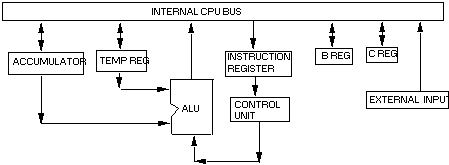
Here is another diagram for your reference.
In the above diagram you notice that there is no address buffer or data buffer, no flags coming out of the ALU and are ignoring many of the registers. These simplifications make the problem manageable while still illustrating many principles. In addition, an external input has been added to allow us to input values to the CPU bus for testing purposes. With the CPU built we will execute micro-operations to make the circuit execute instructions. Each register stores one bit of data and requires two control signals. Register-in loads the register with the contents of the bus. Register-out enables the tri-state buffer in the register which lets the register's output onto the bus. The ALU performs two operations, XOR and AND. The operation to be performed is to be determined by the code in the IR. A 0 in the IR indicates a XOR operation and a 1 indicates an AND operation.
ACCout, ACCin, TMPout, TMPin, ALUout,
IRin, Bout, Bin, Cout, Cin, EXTout.
A control unit would normally generate these control signals but
in our case input pins will be used for these control signals.
Registers
When you build a CPU, you need registers to hold the instruction, operands, etc. as shown in the CPU structure diagram.Here is a demonstration of how to use 1-bit, 2-bit, 8-bit registers.
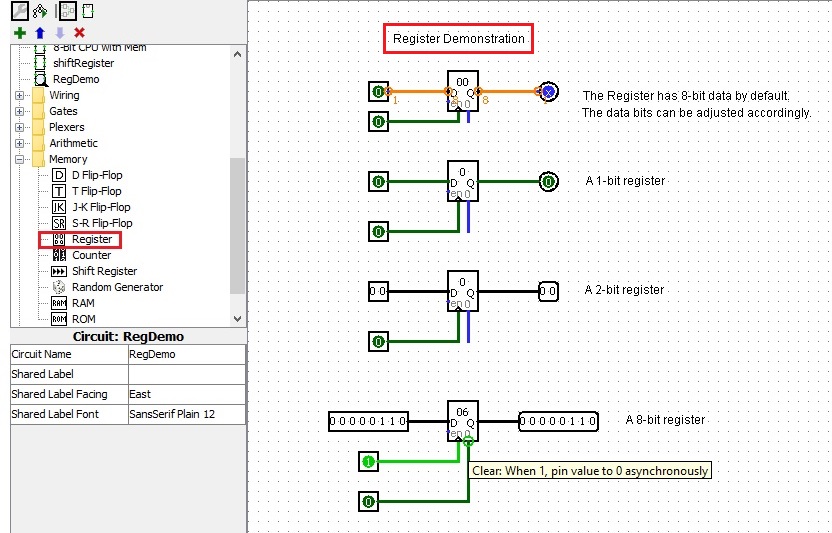
TRI-STATE BUFFER
In order to be able to build a CPU, we will have to look at how several registers/devices are connected to a common bus without causing short circuits and blown chips.Imagine if one device is outputting a one and the other a 0 then what will be the output on bus? To avoid this problem we use a device called a tri-state buffer, which besides the states 0 and 1 has a floating third state.
These can be used to connect several devices to a bus and open one at a time. The tri-state buffers (or controlled buffers) are held in the floating state
except when that device wants to take control of the bus.
If there are more than one devices that try to take control of the bus at the same time there will be a conflict problem.
Here is a demonstration of using 1-bit, 2-bit, and 8-bit tri-state buffer:
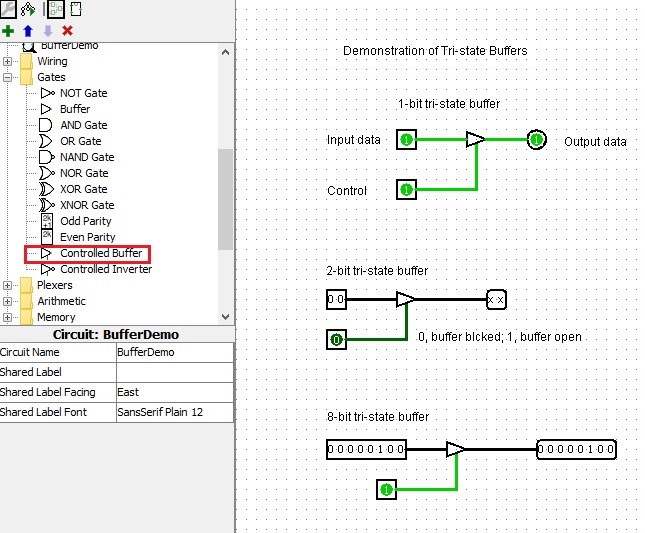
Multiplexers (MUX-4)
A multiplexer is a combinational logic circuit designed to select one of several input lines to a single common output line accordig to the selection control signals. For example, 2-1 Multiplexer has one control signal, 4-1 Mutiplexer has two control signals, 8-1 Multipleaxer has three control signals and so on.Here is a demonstration of 4-1 Multilexer with four input lines D0, D1, D2, D3 for your reference. This device can be used as the control unit of your 2-bit or 8-bit CPU circuit.
Truth Table of a 4-1 Multiplexer (MUX 4) ======================================== Input Selection Output ---------------------------------------- S1 S0 Q D0 0 0 D0 D1 0 1 D1 D2 1 0 D2 D3 1 1 D3 -----------------------------------------
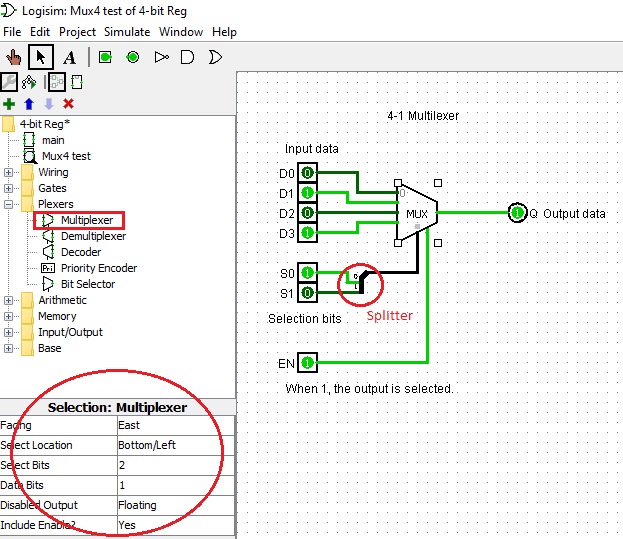
Decoders
A docoder could serve as the control unit for your CPUs. It is worthwhile to investigate the the decoders.
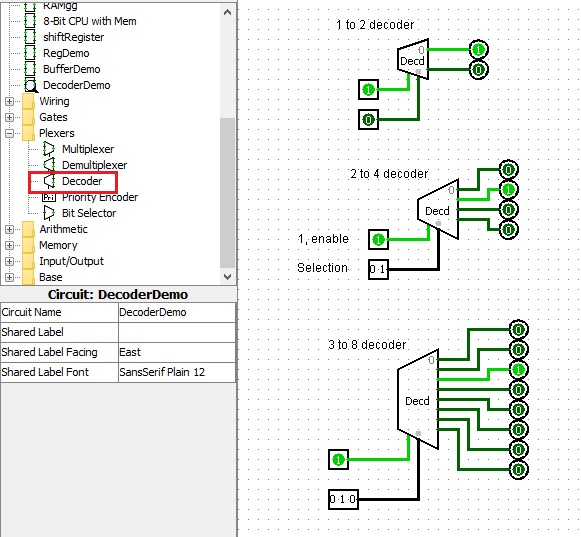
Build a 1-bit CPU
Many devices may be connected to a common bus by using tri-state buffers. You may build a 1-bit CPU as described above to get a feel about it.Here is a picture of the 1-bit CPU circuit for your reference.
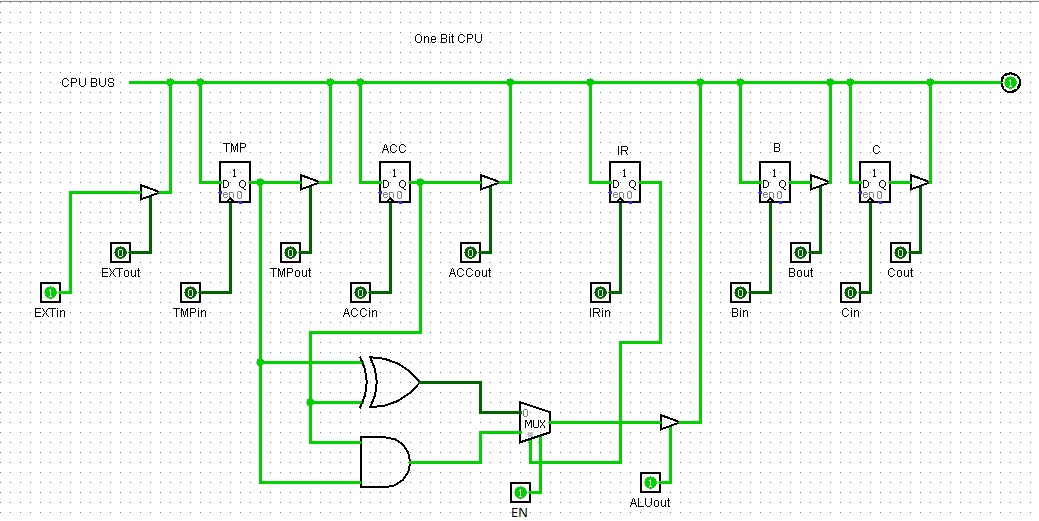
- In the above 1-bit CPU , What are these control signals EXTin, EXTout and Cin for?
- Design the bove 1-bit CPU descriped in the section one of the lab notes and implement the circuit.
Here are Some Relevant Details:
The ALU performs two operations, XOR and AND. The operation to be performed is to be determined by the code in the IR. The value 0 in the IR indicates an XOR operation and the value 1 indicates an AND operation.
The following control signals will be required for our 1-bit CPU in this lab:
ACCout, ACCin, TMPout, TMPin, ALUout, IRin, Bout, Bin, Cout, Cin, EXTout, EXTin. - To implement the operation AND, let's assume that
it uses the operands in registers B and C, and then stores the result in C.
The following instructions would have to be executed.
(assume the external input pin is set to the value '1' - the pre-condition for the AND operation):
And of course, register B and C should be pre-loaded with desired values.At the beginning, set all the "out" pins to '0' so that the bus will be available for use without conflicts. 1. EXTin, EXTout, IRin. // Load '1' in register IR for AND operation. 2. EXTin, EXTout, Bin. // Load '0' in register B. 3. EXTin, EXTout, Cin. // Load '1' in register C. 4. Bout, ACCin. 5. Cout, TMPin. 6. ALUout, Cin.Practice these microinstructions with your newly built 1-bit CPU. -
Do the following experienment:
Write out the steps necessary to implement the operation XOR that uses the operands in the accumulator and register C, and then stores the result in register B.
Lab Assignment